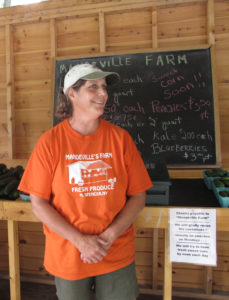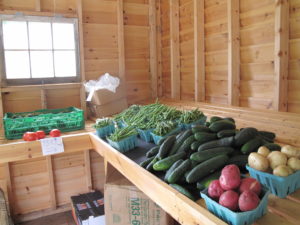From farm to market: choosing the right marketing channel for your farm

Janet Mandeville of Mandeville Farms in Spencer, NY worked with Cornell Cooperative Extension to evaluate which of her marketing channels. Photo by Rebecca Schuelke Staehr
The list of where, and how, to sell produce, milk, meat and other items raised on the farm is long. Today, many farmers are making sales through farmers markets, farm shares, roadside stands, grocery stores, websites, festivals.
Most farmers use more than one market channel to get farm goods to the consumer, and most farmers experiment with several ways to sell before landing on the one or more streams that work best.
The best for each farmer may be a little different. Some do well with community-supported agriculture. Others prosper selling wholesale to a broker. For new farmers and those looking for new, or more cost-effective, markets, choosing where, and how, to sell can be a daunting task.
Recognizing that there’s more than one “right way” to sell farm goods, the NY Farm Viability Institute has supported numerous projects to help farmers fine tune marketing models, and share their successful techniques with others. Efforts range from marketing foods through a farmers’ cooperative, direct to schools, with online sales, through home delivery, and much more.The NY Farm Viability Institute is a farmer-run nonprofit group that awards grants to projects that help farmers improve profitability, and develop models for all farmers. The Institute received funds from the NYS legislature and Department of Agriculture and Markets.
So, what works?: Since 2005, the Institute awarded more than 25 grants to projects that help farmers test and improve marketing strategies, which had the all-farmer board of directors wondering: “But, which ones really worked?”
NY Farm Viability uses an outcome based program model: all the projects it funds seek to help farmers improve profitability, and develop models to replicate successful techniques on all farms. Funded project leaders are required to report on how projects lead to new revenue, decreases in operating expenses, new job creation, and other tangible measures of farm profitability. Last fall, board members awarded a grant to Cornell University economist Miguel Gomez to lead an examination of the specialty crop and food marketing projects funded by NY Farm Viability, and determine which techniques were the most beneficial for farmers.

Cornell Cooperative Extension hopes to collect enough data from farms to offer benchmarks for labor effeciency, profitabity, and more. Photo by Rebecca Schuelke Staehr
“We turned the tables on our own program model, and asked an economist to review the projects that are working on marketing local food. We want to be able to make better recommendations to farmers about what works, and, also, to have more guidance when selecting new projects for grant funds,” said John Lincoln, chair of the NY Farm Viability board of directors. The evaluation will wrap up in late 2011. Extension bulletins and other outreach are expected.
At the same time NY Farm Viability asked Cornell to evaluate the farm benefit of cooperative marketing, online sales, and myriad other marketing routes, they awarded grant funds to Cornell Cooperative Extension of Tompkins County to help farmers assess the profitability and labor costs at each farm’s various marketing channels.
Mandeville Farm in Spencer, NY sells fresh produce at two farm stands, two farmers markets, and to a grocery store. “We were pretty sure the road stands were the way to go, but we wanted to look at that,” said Janet Mandeville.
In evaluating the various marketing channels, road side stands proved the most profitable for the Mandeville family – there’s minimal labor at the stand. Other farms in the study found community-supported agriculture to be the best bet for them.
Results may vary by farm, but the important commonalty, said Matt LeRoux, an agriculture marketing educator with CCE Tompkins County, is record keeping – tracking how much time and money goes into each marketing effort. “Some farms don’t do accounting and may not know if they are making a profit. Some farms don’t do channel-specific accounting, so they don’t know what’s most profitable,” LeRoux said. He has grant funds to help New York farmers evaluate their marketing channels through December 2011, and hopes to collect enough data to offer farmers benchmarks for marketing channel performance.
For more information about the marketing channel research, or to participate in the study, contact the NY Farm Viability Institute.

